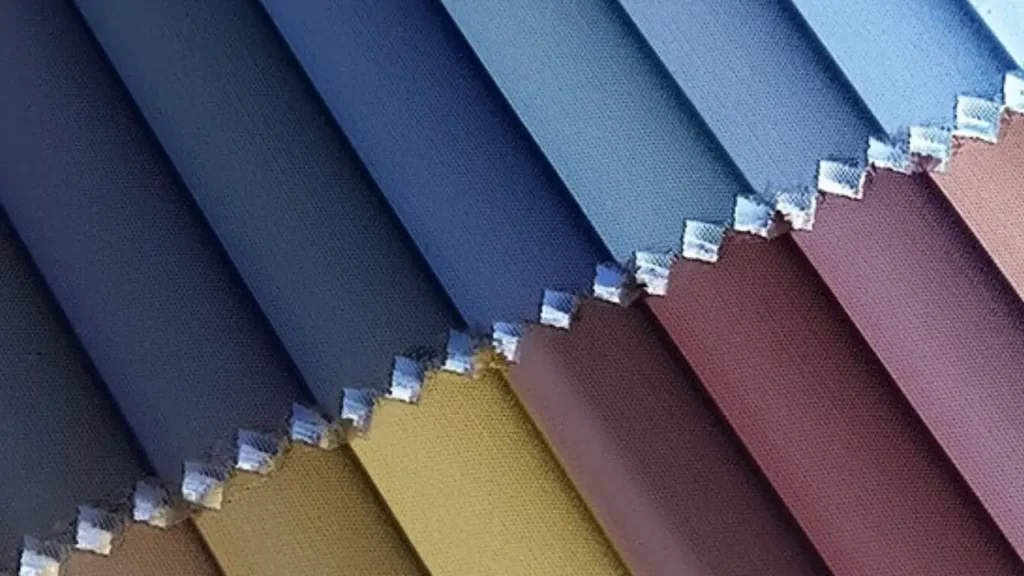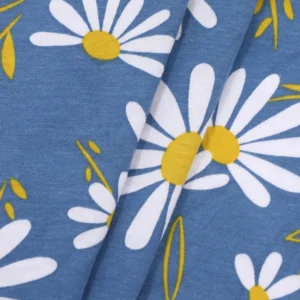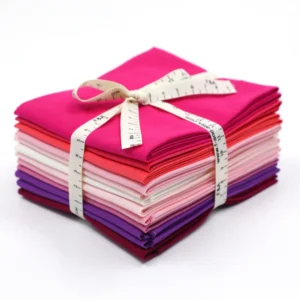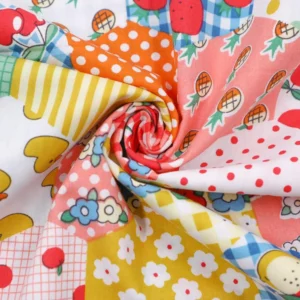Cotton blend fabrics combine the natural comfort of cotton with the enhanced properties of other fibers, creating versatile textiles suitable for diverse applications. Understanding these blends is essential for selecting the right fabric for specific needs, whether for apparel, home textiles, or industrial use.
This blog post will explore the various types of cotton blend fabrics, detailing their unique benefits and practical applications. We’ll delve into the specific advantages of each blend, such as improved durability, wrinkle resistance, and enhanced comfort, providing insights to help you make informed decisions.
What Is Cotton Blended Fabric
Cotton blended fabric is a textile created by combining cotton fibers with other natural or synthetic fibers during the yarn spinning process. This technique aims to enhance the inherent properties of cotton, such as its breathability and comfort, with the desirable characteristics of other fibers, like durability, wrinkle resistance, or improved drape. The resulting fabric offers a balance of qualities, often exceeding the performance of 100% cotton.
Common blending partners include polyester, rayon, modal, and spandex. Each combination yields a fabric with unique characteristics tailored to specific applications. For instance, cotton-polyester blends are popular for everyday apparel due to their durability and ease of care, while cotton-spandex blends provide stretch and flexibility for activewear. The versatility of cotton blends makes them a staple in various textile industries.
Cotton Blend Fabric Types

Cotton blend fabrics offer a versatile range of textiles, each tailored for specific applications by combining cotton’s natural comfort with the enhanced properties of other fibers. Here are some prevalent cotton blend fabric types, along with their benefits and applications.
Cotton-Polyester Blends
Fabric Blends: Cotton-polyester blends typically combine cotton fibers with polyester fibers in varying ratios, commonly ranging from 50/50 to 65/35 (cotton to polyester). This combination leverages cotton’s breathability and softness with polyester fabric‘s durability and wrinkle resistance. The polyester fibers, often spun into a fine yarn, interlock with the cotton fibers to create a robust and versatile textile.
Benefits: The primary benefits of cotton-polyester blends include enhanced durability, reduced shrinkage, and improved wrinkle resistance compared to 100% cotton. The polyester component also contributes to faster drying times and increased color retention. These blends maintain a comfortable feel while offering practical advantages for everyday wear and frequent washing. The balance of comfort and durability makes them a popular choice for a wide range of applications.
Applications: Cotton-polyester blends are widely used in everyday apparel, such as shirts, pants, and dresses, due to their ease of care and durability. They are also prevalent in workwear, uniforms, and bedding, where longevity and minimal maintenance are essential. The blend’s versatility extends to home textiles, including curtains and upholstery, where its strength and wrinkle resistance are highly valued. These blends are also used in athletic wear, as they offer a good balance of comfort and performance.
Cotton-Rayon Blends
Fabric Blends: Cotton-rayon blends combine cotton fibers with rayon, a semi-synthetic fiber derived from cellulose. Rayon, also known as viscose, adds a silky smoothness and enhanced drape to the cotton fabric. The blend ratio can vary, but often aims to balance cotton’s natural feel with rayon’s luxurious texture. The rayon fibers, being smooth and fine, interlock with cotton to produce a soft and flowing fabric.
Benefits: Cotton-rayon blends offer a soft, luxurious feel with improved drape and fluidity compared to 100% cotton. Rayon’s smooth texture enhances the fabric’s comfort, making it pleasant against the skin. These blends are also more absorbent than pure cotton, contributing to their comfort in warm climates. The blend retains cotton’s breathability, making it suitable for various clothing applications.
Applications: Cotton-rayon blends are commonly used in apparel that requires a soft, flowing drape, such as dresses, skirts, and blouses. They are also popular for loungewear and sleepwear due to their comfort and smooth texture. The blend’s enhanced drape makes it suitable for creating elegant and stylish garments. These blends are also found in home textiles, such as curtains and decorative pillows, where their soft texture and luxurious appearance are desirable.
Cotton-Spandex Blends
Fabric Blends: Cotton-spandex blends combine cotton fibers with spandex, also known as elastane, a synthetic fiber known for its exceptional elasticity. Spandex adds stretch and recovery to the cotton fabric, allowing for a comfortable and form-fitting fit. The blend ratio typically includes a small percentage of spandex, usually between 2% and 10%, to maintain the cotton’s natural feel while providing the necessary stretch. The spandex fibers are woven or knitted into the cotton fabric to create a flexible textile.
Benefits: Cotton-spandex blends offer enhanced stretch and flexibility, providing a comfortable and form-fitting fit. These blends allow for greater freedom of movement, making them ideal for activewear and fitted garments. The spandex component ensures the fabric retains its shape and recovers well after stretching, preventing sagging or bagging. The blend maintains cotton’s breathability, ensuring comfort during physical activity.
Applications: Cotton-spandex blends are widely used in activewear, sportswear, and fitted apparel, such as leggings, yoga pants, and form-fitting tops. They are also popular for denim and other fitted garments that require stretch and comfort. The blend’s flexibility makes it suitable for creating comfortable and stylish clothing that moves with the body. These blends are also used in hosiery and underwear, where stretch and comfort are essential.
Cotton-Modal Blends
Fabric Blends: Cotton-modal blends combine cotton with modal, a semi-synthetic fiber derived from beech tree pulp. Modal is known for its exceptional softness, smooth texture, and high moisture absorption. The blend aims to enhance cotton’s comfort and drape, resulting in a fabric that feels luxurious against the skin. Modal fibers, being fine and smooth, interlock with cotton to produce a silky, flowing textile.
Benefits: Cotton-modal blends offer a superior level of softness and a silky texture, making them incredibly comfortable for everyday wear. Modal adds a subtle sheen and enhances the fabric’s drape, resulting in garments that look elegant and feel luxurious. These blends are also highly absorbent, making them suitable for warm climates and active wear. The fabric retains cotton’s breathability, ensuring comfort throughout the day.
Applications: Cotton-modal blends are commonly used in high-quality apparel, such as lingerie, loungewear, and premium t-shirts. Their soft texture and luxurious drape make them ideal for garments that require a refined look and feel. These blends are also popular for bedding and towels, offering exceptional comfort and moisture absorption. The fabric’s smooth texture and elegant appearance make it a preferred choice for upscale home textiles.
Cotton-Linen Blends
Fabric Blends: Cotton-linen blends combine the natural texture of linen with the softness of cotton. Linen, derived from flax fibers, adds a crisp, textured feel to cotton, while cotton softens linen’s inherent stiffness. The blend aims to balance linen’s durability and unique aesthetic with cotton’s comfort. The resulting fabric offers a relaxed yet refined look, combining the best of both natural fibers.
Benefits: Cotton-linen blends offer a breathable and comfortable fabric with a unique, textured appearance. Linen’s natural strength and durability are combined with cotton’s softness, resulting in a fabric that is both stylish and practical. These blends are ideal for warm weather, as both cotton and linen are highly breathable and moisture-wicking. The blend reduces linen’s tendency to wrinkle, making it more manageable for everyday wear.
Applications: Cotton-linen blends are popular for summer clothing, such as shirts, pants, and dresses, offering a relaxed and stylish look. They are also used in home textiles, including curtains, tablecloths, and bedding, adding a touch of natural elegance to interiors. The blend’s unique texture and breathability make it suitable for a wide range of applications, from casual wear to sophisticated home decor.
Cotton-Wool Blends
Fabric Blends: Cotton-wool blends combine the warmth and insulation of wool with the comfort and breathability of cotton. Wool fibers, known for their thermal properties, are blended with cotton to create a fabric that offers warmth without being overly heavy. The blend ratio is carefully chosen to achieve the desired balance of warmth and comfort.
Benefits: Cotton-wool blends provide excellent warmth and insulation, making them suitable for cooler climates. The blend retains cotton’s breathability, preventing overheating and ensuring comfort. Wool’s natural moisture-wicking properties keep the wearer dry, while cotton adds softness and reduces itchiness associated with pure wool. These blends offer a comfortable and practical solution for cold-weather apparel.
Applications: Cotton-wool blends are used in sweaters, cardigans, and other cold-weather apparel, providing warmth and comfort. They are also used in blankets, throws, and other home textiles, offering a cozy and comfortable feel. The blend’s versatility makes it suitable for a range of applications where warmth and comfort are essential.
Cotton-Bamboo Blends
Fabric Blends: Cotton-bamboo blends combine the natural softness and breathability of cotton with the silky smooth texture and eco-friendly properties of bamboo viscose or lyocell. Bamboo fibers, derived from bamboo pulp, add a luxurious feel and enhanced moisture-wicking capabilities to cotton. The blend aims to create a fabric that is both comfortable and sustainable.
Benefits: Cotton-bamboo blends offer exceptional softness and a smooth, silky texture, making them ideal for sensitive skin. Bamboo’s natural antibacterial and hypoallergenic properties enhance the fabric’s comfort and hygiene. These blends are highly absorbent and breathable, providing excellent moisture management and comfort in various climates. The eco-friendly nature of bamboo, being a rapidly renewable resource, adds to the blend’s appeal.
Applications: Cotton-bamboo blends are commonly used in intimate apparel, loungewear, and baby clothing, where softness and comfort are paramount. They are also popular for bedding and towels, offering a luxurious and gentle feel. The blend’s moisture-wicking properties make it suitable for activewear and travel clothing.
Cotton-Tencel/Lyocell Blends
Fabric Blends: Cotton-Tencel or cotton-lyocell blends combine the natural comfort of cotton with the smooth, silky texture and sustainable properties of Tencel or lyocell. Both Tencel and lyocell are derived from wood pulp, offering a soft and eco-friendly alternative to rayon. The blend aims to enhance cotton’s drape and moisture management while maintaining its natural feel.
Benefits: Cotton-Tencel/lyocell blends offer a smooth, luxurious texture and excellent moisture-wicking capabilities. Tencel and lyocell add a subtle sheen and enhance the fabric’s drape, resulting in garments that look elegant and feel comfortable. These blends are also highly breathable and hypoallergenic, making them suitable for sensitive skin. The sustainable production of Tencel and lyocell adds to the blend’s appeal.
Applications: Cotton-Tencel/lyocell blends are commonly used in high-quality apparel, such as dresses, blouses, and skirts, where a smooth drape and luxurious feel are desired. They are also popular for bedding and home textiles, offering exceptional comfort and moisture management. The blend’s versatile properties make it suitable for a wide range of applications, from casual wear to sophisticated garments.
Cotton-Silk Blends
Fabric Blends: Cotton-silk blends combine the natural comfort of cotton with the luxurious sheen and smooth texture of silk. Silk fibers, known for their elegance and delicate feel, add a touch of sophistication to cotton. The blend aims to create a fabric that is both comfortable and stylish, suitable for high-end apparel and accessories.
Benefits: Cotton-silk blends offer a luxurious feel and elegant appearance, combining the best of both natural fibers. Silk adds a subtle sheen and enhances the fabric’s drape, while cotton provides comfort and breathability. These blends are lightweight and comfortable, making them suitable for various climates. The blend’s unique texture and appearance make it ideal for creating sophisticated garments.
Applications: Cotton-silk blends are commonly used in high-end apparel, such as evening wear, blouses, and scarves. They are also used in accessories, such as shawls and wraps, adding a touch of elegance to any outfit. The blend’s luxurious feel and appearance make it suitable for special occasions and formal wear.
Cotton-Nylon Blends
Fabric Blends: Cotton-nylon blends combine the natural comfort of cotton with the strength and durability of nylon. Nylon, a synthetic fiber, adds significant tensile strength and abrasion resistance to cotton, enhancing the fabric’s longevity. The blend aims to create a textile that is both comfortable and robust, suitable for demanding applications.
Benefits: Cotton-nylon blends offer enhanced durability and strength, making them ideal for workwear and outdoor apparel. Nylon’s abrasion resistance protects the fabric from wear and tear, while cotton provides breathability and comfort. These blends are also quick-drying, making them suitable for active wear and travel clothing. The combination of strength and comfort makes them versatile for various applications.
Applications: Cotton-nylon blends are commonly used in workwear, such as uniforms and industrial clothing, where durability is essential. They are also popular for outdoor apparel, such as hiking pants and jackets, providing comfort and protection. The blend’s strength and quick-drying properties make it suitable for travel clothing and active wear.
Cotton-Viscose/Rayon Blends (Different Ratios)
Fabric Blends (Higher Viscose/Rayon Content): Cotton-viscose/rayon blends can vary in ratios, with some emphasizing the silky drape and fluidity of viscose/rayon. When viscose/rayon content is higher, the blend exhibits a smoother, more luxurious feel, with enhanced drape and a subtle sheen. This creates a fabric that resembles silk or other high-end materials.
Benefits: Higher viscose/rayon content in these blends results in a fabric with exceptional drape and a smooth, silky texture. These blends are often more absorbent than pure cotton, providing comfort in warm climates. They offer a luxurious feel at a more affordable price point, making them a popular choice for elegant apparel.
Applications: These blends are commonly used in dresses, blouses, and skirts that require a flowing, elegant drape. They are also popular for linings and lightweight summer apparel. The fabric’s luxurious feel and appearance make it suitable for creating sophisticated garments and accessories.
Cotton-Acrylic Blends
Fabric Blends: Cotton-acrylic blends combine the warmth and softness of acrylic with the natural comfort of cotton. Acrylic, a synthetic fiber, adds bulk and warmth to cotton, creating a fabric that is suitable for cooler climates. The blend aims to balance warmth and comfort, resulting in a cozy and practical textile.
Benefits: Cotton-acrylic blends offer excellent warmth and insulation, making them suitable for sweaters, cardigans, and other cold-weather apparel. Acrylic adds bulk and softness, creating a comfortable and cozy feel. These blends are also lightweight and easy to care for, making them practical for everyday wear.
Applications: These blends are commonly used in knitwear, such as sweaters, scarves, and hats, providing warmth and comfort. They are also used in blankets and throws, offering a cozy and comfortable feel. The blend’s versatility makes it suitable for a range of cold-weather applications.
Cotton Blended Fabric Advantages
Cotton blended fabrics offer a multitude of advantages, combining the natural comfort of cotton with the enhanced properties of other fibers. This results in textiles that are not only versatile but also tailored to meet diverse needs.
Enhanced Durability
Blending cotton with stronger synthetic fibers like polyester or nylon significantly increases the fabric’s durability. These blends are more resistant to wear and tear, maintaining their shape and integrity even after frequent washing and use. This makes them ideal for everyday apparel, workwear, and home textiles where longevity is essential. The added strength ensures that the fabric can withstand rigorous use without compromising comfort.
Improved Wrinkle Resistance
Cotton blended with fibers like polyester or rayon reduces the fabric’s tendency to wrinkle. This results in garments that require less ironing and maintain a smooth, presentable appearance throughout the day. This property is particularly beneficial for travel clothing, business attire, and everyday wear, offering convenience and a polished look with minimal effort.
Increased Comfort and Breathability
Blending cotton with modal, rayon, or bamboo enhances the fabric’s softness and breathability. These blends offer a luxurious feel against the skin and improve moisture management, making them comfortable in various climates. The natural breathability of cotton is complemented by the smooth texture and enhanced drape of these fibers, resulting in garments that are both comfortable and stylish.
Enhanced Stretch and Flexibility
Combining cotton with spandex or elastane adds stretch and flexibility to the fabric, allowing for a comfortable and form-fitting fit. These blends are ideal for activewear, fitted garments, and denim, providing freedom of movement and maintaining shape retention. The added elasticity ensures that the fabric moves with the body, offering comfort and support during various activities.
Cost-Effectiveness
Blended fabrics often offer a more cost-effective solution compared to 100% natural fibers like silk or high-quality cotton. By combining cotton with less expensive synthetic fibers, manufacturers can produce textiles that offer desirable properties at a more affordable price point. This makes blended fabrics accessible to a wider range of consumers and suitable for various applications.
Versatility in Design and Application
Cotton blended fabrics offer versatility in terms of design and application. The ability to combine different fibers allows for the creation of textiles with tailored characteristics, such as increased warmth, enhanced moisture-wicking, or unique textures. This versatility makes blended fabrics suitable for a wide range of industries, from fashion and home textiles to industrial and technical applications.
How to Choose the Best Cotton Blended Fabrics
Selecting the best cotton blended fabrics involves considering several factors to ensure they meet your specific needs. The right blend can significantly enhance the fabric’s performance, durability, and aesthetic appeal. Therefore, carefully evaluating the blend ratio, fiber quality, fabric weight, and intended application is crucial for making an informed decision.
Here are key aspects to consider when choosing cotton blended fabrics:
Blend Ratio and Fiber Quality:
The ratio of cotton to other fibers greatly influences the fabric’s characteristics. A higher cotton percentage offers more breathability and natural comfort, while a higher percentage of synthetic fibers enhances durability and wrinkle resistance. Evaluate the quality of each fiber component, as premium fibers contribute to superior fabric performance and longevity. Ensure the fibers are evenly distributed throughout the blend for consistent texture and performance.
Fabric Weight and Texture:
Consider the fabric’s weight and texture based on your intended application. Lighter blends are suitable for apparel requiring drape and comfort, while heavier blends offer durability for upholstery or workwear. The fabric’s texture can range from smooth to textured, influencing its aesthetic appeal and suitability for specific designs. Ensure the fabric’s weight and texture align with the project’s requirements for optimal results.
Performance and Care Requirements:
Evaluate the fabric’s performance characteristics, such as stretch, moisture-wicking, and wrinkle resistance, based on your needs. Blends with spandex offer stretch for activewear, while those with polyester provide wrinkle resistance for everyday apparel. Consider the fabric’s care requirements, ensuring it is easy to maintain and suitable for regular washing or dry cleaning. Ensure the chosen fabric aligns with the desired functionality and ease of maintenance.
Colorfastness and Durability:
Check the fabric’s colorfastness to ensure it retains its hue after washing or exposure to light. High-quality dyes and finishing processes contribute to long-lasting color retention. Assess the fabric’s durability, especially for items that will be subjected to frequent use or stress. Stronger blends and weaves ensure longevity and prevent tears or snags, maintaining the fabric’s integrity over time. Ensure the fabric’s color and durability meet the demands of its intended use.
Conclusion
Cotton blend fabrics offer a versatile solution by combining the natural comfort of cotton with the enhanced properties of other fibers. These blends cater to diverse needs, from everyday apparel to specialized industrial applications, providing a balance of comfort, durability, and performance. Understanding the benefits and applications of various cotton blends empowers consumers and manufacturers to make informed choices.
The ability to tailor fabric characteristics through blending allows for the creation of textiles that excel in both function and aesthetics. Whether it’s the wrinkle resistance of cotton-polyester or the luxurious softness of modal-cotton, these blends demonstrate the textile industry’s innovation in meeting modern demands.
For a comprehensive selection of high-quality wholesale blended fabrics, including a wide array of cotton blends, explore the offerings at Fanda Fabrics. We provide diverse options to meet various project requirements. Contact us today to discover our collection and request a quote, and experience the benefits of premium blended fabrics.






